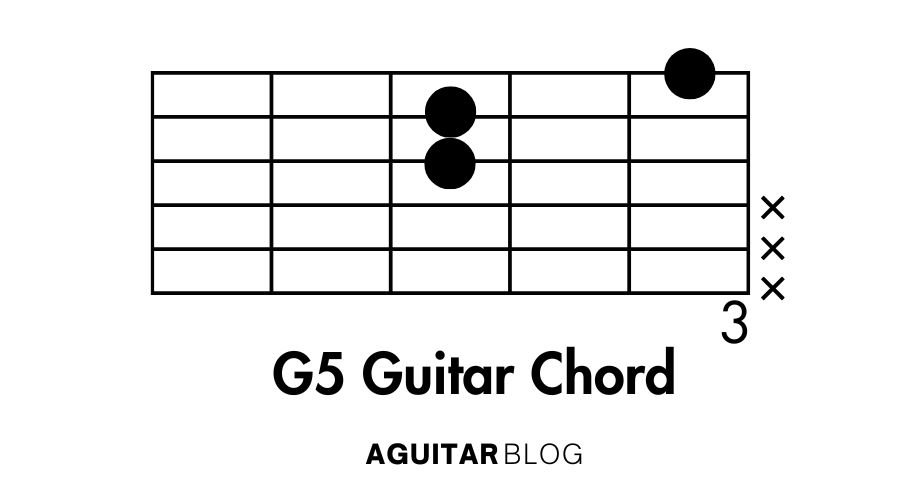The G5 guitar chord is a simple yet powerful chord that creates a clean, open sound. Also known as a power chord, the G5 chord consists only of the root note (G) and the fifth (D), without the third. This gives it a more neutral, non-major or minor feel, making it versatile for rock, punk, metal, and other genres.
What is the G5 Guitar Chord?
The G5 chord is a power chord, which means it includes just the root note (G) and the perfect fifth (D). It omits the third, which would otherwise define whether the chord is major or minor. Because of this, the G5 chord sounds more open and ambiguous, making it ideal for genres that thrive on rhythm and power.
Notes in the G5 Chord:
- Root: G
- Fifth: D
The G5 chord is often used in rock and other genres to create a strong, driving rhythm. Since it’s neither major nor minor, it has a neutral, versatile quality that can be used in a variety of contexts.
How to Play the G5 Guitar Chord

Open G5 Chord (Basic Version):
- Place your index finger on the 2nd fret of the A string (5th string).
- Place your ring finger on the 3rd fret of the low E string (6th string).
- Let the D string (4th string) ring open.
- Let the G string (3rd string) ring open.
- Let the B string (2nd string) ring open.
- Let the high E string (1st string) ring open.
Strum the low E string, A string, and let the other strings ring out for the signature G5 sound.
Barre Chord Version of G5:
- Place your index finger across all strings at the 3rd fret (barre chord).
- Place your ring finger on the 5th fret of the A string (5th string).
- Place your pinky finger on the 5th fret of the D string (4th string).
Strum all six strings for a fuller, more powerful sound of the G5 chord.
Video Tutorial G5 Guitar Chord
For visual learners, a step-by-step video tutorial can make mastering the G5 Guitar Chord much easier. Here’s a helpful guide for you:
Common Mistakes and Tips for Playing the G5 Guitar Chord
Common Mistakes:
- Muted Strings: Make sure that your fingers aren’t accidentally muting any strings, especially the open D string or the 3rd fret of the low E string.
- Buzzing Notes: Barre chords require firm pressure; if you’re using a barre chord version, ensure your index finger is pressing down evenly.
- Strumming the Wrong Strings: Since the G5 chord has a focus on the root (G) and fifth (D), be sure to focus your strumming on the appropriate strings to avoid unnecessary ringing from non-essential notes.
Tips for Success:
- For the open version, start by focusing on the root notes (E and A strings) and the open D string.
- For the barre chord version, ensure that you’re barring all the strings firmly for a clean sound.
- Practice transitioning between the G5 chord and other chords like C5 or D5 to get used to the power chord shapes.
Chord Progressions Featuring the G5 Chord
Common Progressions:
- G5 – C5 – D5: This is a basic power chord progression used in many rock and punk songs.
- G5 – F5 – C5 – G5: A simple, effective progression for a strong rhythmic sound.
- G5 – E5 – A5: Common in rock and metal, the G5 chord adds power to this fast-moving progression.
Songs Featuring the G5 Chord
The G5 chord is found frequently in rock, metal, and punk genres. Here are a few examples:
- “Smells Like Teen Spirit” by Nirvana (The entire song is based on power chords, including G5).
- “Iron Man” by Black Sabbath (The riff uses power chords like G5 and others).
- “Bad to the Bone” by George Thorogood (The intro riff includes the G5 chord).
Practice Tips for the G5 Chord
- Work on Finger Placement: Power chords can be tricky for beginners, so it’s essential to ensure the proper finger placement to avoid muting strings or creating unwanted buzzing.
- Focus on Clean Strumming: Practice strumming only the strings you need to hit. You can mute strings you don’t want to ring out using your palm or unused fingers.
- Use a Pick for Clarity: Power chords often sound best with a pick. Use alternate picking to get a steady rhythm when practicing the G5 chord.
Conclusion
The G5 guitar chord is one of the simplest and most effective chords you can learn. Its neutral, open sound makes it a staple in rock, metal, punk, and other rhythm-heavy genres. Whether you’re strumming open power chords or mastering barre chord versions, the G5 chord offers flexibility and a solid foundation for many musical styles. Practice the chord and explore its potential in various progressions to enhance your guitar playing!